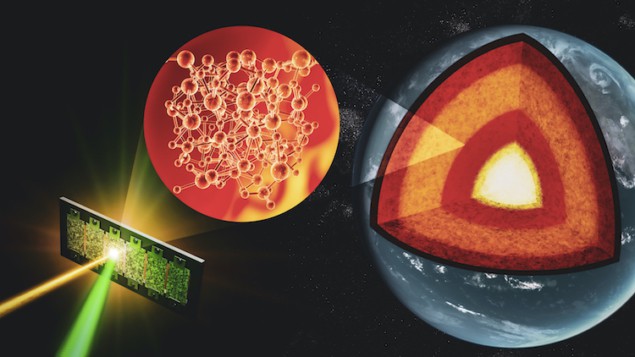
A technique that reproduces the conditions of the Earth’s mantle at a depth of more than 2000 km could help researchers simulate our planet’s earliest days, when magma covered its surface. The technique, which combines laser-driven shock experiments with X-ray free-electron laser measurements, provides nanosecond-resolution information on the transformations that occur in silicate materials at ultrahigh pressures and temperatures. The work adds to our understanding of the present-day core-mantle boundary and may even shed light on conditions inside “super-Earths” – rocky exoplanets similar to Earth but larger in size.
Terrestrial planets like Earth have silicate-based mantles and iron-rich cores. This structure is thought to be the result of various material-differentiation processes that took place at an early stage of the planet’s development, including radiogenic decay of short-lived nuclides and numerous shock events. Together, these processes created temperatures high enough to sustain a planet-wide ocean of magma.
To better understand what happened during this epoch in the history of Earth and other rocky planets, researchers need to analyse the physical properties of liquid silicates under similar conditions. Such studies could help determine the composition and origin of molten or partially molten domains of liquid silicates that exist in the Earth’s upper mantle today, and possibly also at the boundary between the mantle and magmatic core, which is a vestige of those primordial days.
Doing away with extreme-condition apparatus
Temperatures as high as 6000 K and pressures of more than 100 GPa are, however, difficult to create in the laboratory. For this reason, researchers at Sorbonne University and the University of Grenoble-Alpes in France, together with colleagues at the US Department of Energy’s SLAC National Accelerator Laboratory, developed an alternative method that eliminates the need for ultrahigh-pressure/extreme temperature apparatus. The new technique involves first sending a shockwave through an amorphous magnesium silicate sample using an optical laser. This step, performed at SLAC’s Linac Coherent Light Source (LCLS) X-ray free-electron laser (XFEL), compresses the sample to pressures of up to 130 GPa and heats it to temperatures of 6000 K. The silicate glass thus transforms into a liquid.
Next, they bombarded the sample with ultrafast femtosecond X-ray pulses from the LCLS at the precise moment when the shockwave reached the desired pressure and temperature. These X-rays produced two precise diffraction peaks as they scattered off the sample, enabling the researchers to monitor how the atoms in the sample rearranged themselves at such high pressure and temperatures. The resulting spectral fingerprint is related to the transition from four-fold to six-fold coordination of oxygen atoms around the silicon atoms.
Aside from this atomic rearrangement, the researchers saw no other major structural changes in the silicate melts at pressures of up to 130 GPa – a finding that should be important for better modelling these materials under the conditions present deep inside the Earth, they say.

High-pressure experiment sheds light on Earth’s outer core
The team backed up their results with measurements previously obtained in conventional diamond anvil analyses – in which a solid silicate sample is literally crushed to high pressures at room temperature – and molecular dynamics simulations.
Recreating Earth’s early days
“Through our experiments, we have been able to probe geophysical materials at the extremely high temperatures and pressures found deep inside the Earth, to characterize their liquid structure and learn how they behave,” explains study lead author Guillaume Morard. “These studies will allow us to recreate Earth’s early days and understand the processes that shaped our planet.”
The researchers now plan to repeat their experiments at higher X-ray energies. This should enable them to more precisely measure the way in which the atoms rearrange in the liquid silicates. They also hope to try out higher pressures and temperatures. “These latter studies will be important for better understanding how silicate liquids and glasses behave in super-Earth planets,” says Morard.
The work is detailed in PNAS.



